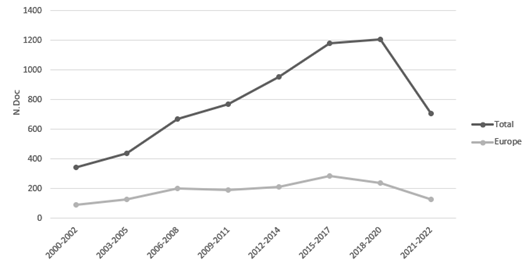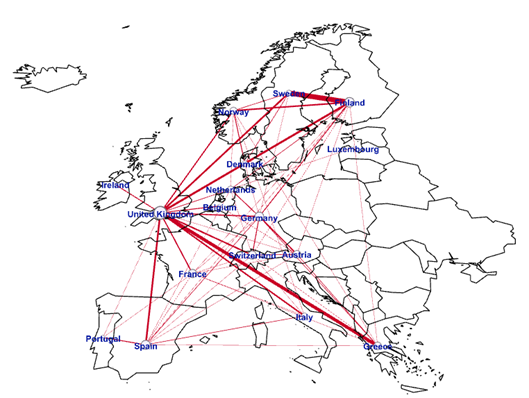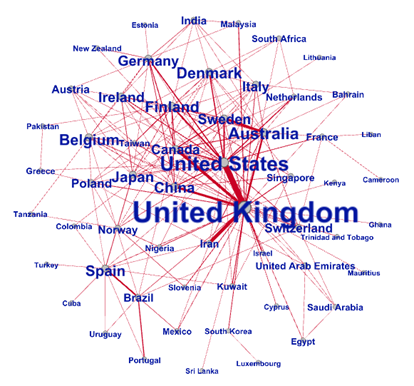1. Introduction
For any researcher who studied information behaviour (IB) in the last decades of the 20th century, at least in Europe, the University of Sheffield and the training, dissemination, and research activities carried out by the Centre for Research on User Studies (CRUS) were the undisputed reference points. In those days, the CRUS guides and the various articles that appeared in the Journal of Documentation describing the phases of the INISS project (Information Needs and Information Services in Social Services), among other texts, were compulsory reading as an introduction to the subject. Subsequently, the successive models of Tom Wilson and David Ellis, among others, represented a style of doing research that, seeking rigour and consolidation of the knowledge acquired, allowed us to enter the exciting world of social research applied to the problems of library and information science (LIS). Subsequently, the initiation of the Information Seeking in Context (ISIC) conference series allowed access to the results of research carried out in other countries with different approaches. ISIC undoubtedly contributed to the institutionalisation of the field, with IB research now appearing as one of the main topics in LIS (Sugimoto et al., 2011).
More recently, several studies have investigated the characteristics of international IB research in the early years of the 21st century. Thus, Julien and O'Brien (2014), through content analysis, presented an area that arouses more interest in researchers than in information professionals, where a quantitative methodology predominates, a growing interest in users in the context of everyday life, and with constant use over time of theoretical support in the design of research. Other bibliometric studies have qualified some of these issues. Thus, for González Teruel et al. (2015), IB research between 2000 and 2012 was an area with an eminently theoretical intellectual base produced by a community in which a small number of researchers could be considered stable and a large number of them were transient. This may reflect an area that is not yet consolidated, although this is common in the social sciences and humanities (Ioannidis et al., 2014). For their part, Deng and Xia (2020) observed growing interdisciplinarity in the period from 2000 to 2018, in view of the disciplines contributing to IB research. Finally, Deng et al. (2021) noted the existence of six thematic areas in the IB literature between 2009 and 2018: the study of patients' IB, information interactions in digital environments, information literacy in health and academic contexts, health literacy on the internet, information behaviour in child-centred studies, and information behaviour in medical informatics.
In general, we can affirm that the study of IB continues to be an exciting line of research, as it has been since its inception. It remains dynamic both theoretically and methodologically. It shares the same challenges that LIS in general faces, as an academic and professional area in a world in which we hear more about communication than information. And IB research is no longer only carried out in the countries of the North. There are numerous research groups in Ibero-American countries that have much to contribute to the consolidation of the area, not only as recipients of what is researched in Europe and North America, but also as promoters of research of great interest due to their rigour and creativity in approaching the object of study and the contribution of their results to user knowledge (González Teruel et al., 2022).
In this context, in this monographic issue of the journal Informatio, this paper aims to contribute to global knowledge of the study of IB by offering a map of European research during the 21st century from quantitative and qualitative points of view. From a quantitative point of view, we detail the countries and institutions whose researchers have published results. From a qualitative point of view, we describe the researchers and areas of study at the main European research centres.
2. Methods
The characterisation of IB research in Europe was carried out on the basis of scientific publications indexed in the Scopus database. Table 1 presents the strategy employed, as well as the limits that were applied.
Table 1: Search strategies
| Field | Strategy |
|---|---|
| TITLE-ABS-KEY | "Information seeking" OR "information behavior" OR "information behaviour" OR "information seeking behavior" OR "information seeking behaviour" OR "user studies" OR "user study" OR "information practice*" OR "information sharing behavior" OR "information sharing behaviour" OR "information searching behavior" OR "information searching behaviour" OR "information use behavior" OR "information use behaviour" OR "information needs" |
| DOCTYPE | Article or review |
| PUBYEAR | 2000-2022 |
| LANGUAGE | English OR Spanish OR French OR Portuguese OR Italian Or Catalan |
| AREA | Library and Information Sciences journals |
This strategy, which has already been tested in previous works (González-Teruel et al., 2015), was constructed by considering the three dimensions of Wilson's (1999) model (information behaviour, information seeking behaviour, and information searching behaviour) as well as the alternative expression "information practice" and other traditional terms, such as "user studies" and "information needs". The search was also limited to Western European countries.
From the retrieved records, the author and institution were revised and standardised in order to unify the different names. After retrieving the works, a double analysis was carried out. On the one hand, from a quantitative point of view, the following aspects were analysed:
- Number of papers, evolution of production, and contribution of European research to total IB research.
- Scientific production and collaboration by country and institution.
- Production and collaboration between authors.
- Authors with stable production throughout the period observed (>9 papers).
Starting with works published by the authors with stable production, a co-authorship network was obtained by identifying the research nuclei or components. In social network analysis, a component is a group of directly or indirectly interconnected nodes (authors). In this context, this connection reflects joint authorship or co-authorship. Typically, in co-authorship networks, there is a giant or main component, i.e. the one that groups the largest number of nodes that make up the network. There may also be smaller components, and even some isolated nodes. A qualitative analysis of the identified research nuclei was carried out to identify the most productive authors in each nucleus, as well as their institutional links and main lines of research. The latter information was obtained from both their publications and their public research profiles. Finally, Bibexcel and Gephi software were used to generate, analyse, and visualise the networks.
3. Results and discussion
We retrieved 1,473 papers that served as the basis for characterising European IB research (Figure 1). According to SCOPUS data, this number represents 23.5% of global output between 2000 and 2022. Specifically, it represents 26.9% of global output in the first three years (2000-2002), 30% between 2006 and 2008, and 19.8% between 2018 and 2020. These changes over time in the European share of global output could be attributed to the progressive incorporation of researchers into an area that has been achieving its own identity within LIS (Milojevic et al., 2011). They may also be due to the inclusion in Scopus of new journals from non-English-speaking countries, giving greater visibility to researchers from these geographical areas.
3.1 Countries and institutions
3.1.1 Scientific output
The 1,473 papers were published by researchers from 880 institutions in 59 different countries, 18 of them European (Table 2). A remarkable fact is that northern European countries are the largest contributors, with United Kingdom leading the way, since 46.3% of the papers include an author affiliated with an institution in that country. Behind the United Kingdom, but with much lower figures, are Finland, Spain, Sweden, and Germany, all of them with 100 or more papers published in the period. With the exception of Finland and Sweden, the rest of these countries also achieve prominent positions in European scientific production in LIS (Olmeda-Gómez & Moya-Anegón, 2016).
Table 2: Number of papers by country of affiliation of their authors
| Country | Ndoc | % |
| United Kingdom | 683 | 46.3 |
| Finland | 178 | 12.1 |
| Spain | 133 | 9.0 |
| Sweden | 106 | 7.2 |
| Germany | 102 | 6.9 |
| Denmark | 80 | 5.4 |
| Greece | 56 | 3.8 |
| Italy | 48 | 3.3 |
| Norway | 40 | 2.7 |
| Netherlands | 40 | 2.7 |
| France | 39 | 2.6 |
| Ireland | 38 | 2.6 |
| Belgium | 22 | 1.5 |
| Switzerland | 20 | 1.4 |
| Portugal | 15 | 1.0 |
| Austria | 10 | 0.7 |
| Iceland | 9 | 0.6 |
| Luxembourg | 2 | 0.1 |
When looking at the institutions, again, it is institutions from northern European countries that appear in at least 20 papers, except in the case of the Ionian University of Greece (Table 3). Particularly striking are the nine institutions from the United Kingdom, led by the University of Sheffield. There are also three Finnish institutions (University of Tampere, Åbo Akademi University, and University of Oulu), the University of Copenhagen in Denmark, two Swedish universities (University of Borås and Uppsala University), and University College Dublin in Ireland.
Table 3: Institutions with the highest number of papers (20 or more)
| Institution | Ndoc | % |
| University of Sheffield | 101 | 6.9 |
| University of Tampere | 100 | 6.8 |
| City, University of London | 74 | 5.0 |
| University College London | 66 | 4.5 |
| University of Strathclyde | 58 | 3.9 |
| University of Copenhagen | 50 | 3.4 |
| Northumbria University | 43 | 2.9 |
| Åbo Akademi University | 41 | 2.8 |
| Robert Gordon University | 40 | 2.7 |
| Loughborough University | 32 | 2.2 |
| University of Borås | 32 | 2.2 |
| Manchester Metropolitan University | 28 | 1.9 |
| Uppsala University | 26 | 1.8 |
| Ionian University | 23 | 1.6 |
| Aberystwyth University | 22 | 1.5 |
| University College Dublin | 20 | 1.4 |
| University of Oulu | 20 | 1.4 |
3.1.2. Scientific collaboration between countries and institutions
From the point of view of scientific collaboration between countries, in most of the publications, only one country appears (n = 1106; 75.1%), all of them European, given the search strategy used in this research. On the other hand, in 24.5% (n = 367) of the publications, more than one country appears. In this case, 108 papers contain two or more European countries (7.3%; intra-European collaboration) and 259 contain a European country together with countries from Eastern Europe or other continents (17.6%; international collaboration).
On the other hand, the most frequent collaboration between countries was between Finland and Sweden (n = 17). The country with the most collaborations with other countries was the United Kingdom, especially with Nordic countries as a whole (n = 23) and with Greece (n = 11; see Figure 2).
In terms of collaboration between European countries and others beyond the geographical area studied (Figure 3), it was again the United Kingdom that collaborated the most. Most of this collaboration was with the USA (n = 35), Iran (n = 19), Canada (n = 16), China (n = 13), and Australia (n = 10). Also noteworthy is the collaboration between Sweden and Australia (n = 14), as well as between Scandinavian countries and the USA (n = 18). Other important collaborations were between Spain and Portugal and various Ibero-American countries such as Brazil, Colombia, Cuba, and Mexico (n = 18).
The data on collaboration between countries corroborate what Ardanuy and Urbano (2015) observed with regard to European scientific collaboration: when it does occur, it is most often within a single country, and when two or more countries are involved, these are preferably from outside Western Europe. As these researchers state, it does not seem that the recent European policies of integration in university, science, and technology matters have been successful among researchers in the area, with independent silos still being maintained without stable collaborations.
With regard to collaboration between institutions, 51.7% of the papers included only one institution, 30.4% included two institutions, and 17.9% had three or more institutions (Table 4). There are no stable collaborations that are worth highlighting. Only University College London and Tarbiat Moallem University have more than 10 collaborations. As seen below, this is a consequence of the scientific activity of the CIBER research group in the United Kingdom.
3.2 Research nuclei: authors and lines of research
3.2.1. Production
A total of 2,298 authors were identified in the 1,473 IB papers that we analysed. Of these, 79.6% (n = 1829) of the authors published a single paper for more than 20 years (Table 5). These are transient authors, which, in the opinion of Schubert and Glänzel (1991), are natural in any discipline but can be unhealthy if the total number of authors is high, as it constitutes an obstacle to the flow and exchange of information, and thus impedes scientific progress. This is a result that coincides with previous work analysing IB research (González Teruel et al., 2015) and is in line with that obtained by Lariviere et al. (2012) for LIS in general. These authors attribute this to the incursion of researchers from other areas (interdisciplinarity) and to the increase in the number of doctoral students. On the other hand, we found that the 28 authors with the highest productivity (>9 papers) in the years observed together published a total of 402 papers, representing 27.3% of the papers analysed.
3.2.2. Scientific collaboration between researchers
Of the papers we analysed, 70.9% of them were collaborative, which is slightly higher than the figure obtained by Han et al. (2014) for LIS in general between 2000 and 2011. The author-to-paper ratio was 2.5. The analysis of the co-authorship of publications by the most productive collaborative researchers identified nine clusters. In this regard, it should be noted that, in order to elaborate the co-authorship network and identify these clusters, the papers published by the 28 authors with a production of more than nine papers together with their co-authors, whether or not the latter were major producers, were used as a starting point (Figure 5).
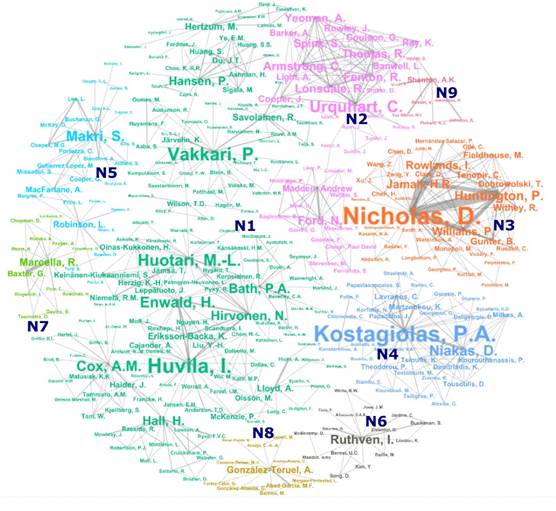
Figure 5: Co-authorship network of the most productive authors (researcher size weighted by number of collaborations)
Of the nine research nuclei identified, one stands out as having the largest number of researchers: 158 researchers (N1 in Figure 5). This is the so-called giant or main component and is the heart of the area. A detailed observation of this main component (Figure 6) allows us to identify, in turn, small networks or nuclei linked to each other by researchers who act as bridges. Nine other sub-nuclei are described below.
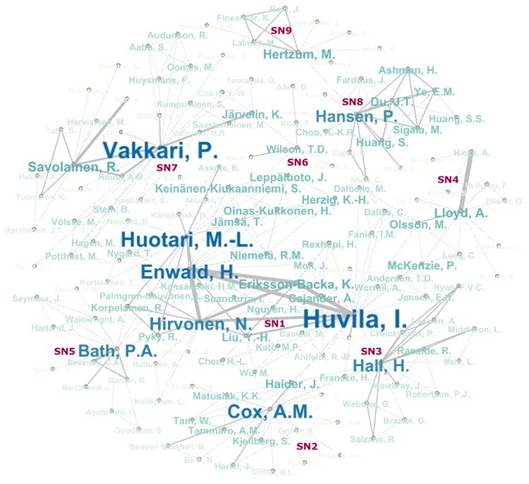
Figure 6: Co-authorship network of the research nucleus with the most researchers (Nucleus 1) (researcher size weighted according to the number of collaborations)
The first of these sub-cores within the main core is made up of three of the most productive researchers linked to three of the most productive universities, all three from northern European countries (Figure 6. SN-1). These are Huvila from Uppsala University (Sweden) and Åbo Akademi University (Finland), with 22 papers; Huotari from the University of Oulu (Finland), with 10 papers; and Hirvonen from both the University of Oulu and Åbo Akademi University, who has been publishing on IB since 2015, with 10 papers.
Huvila's research, first published in IB in 2008, focuses on «information and knowledge management, information work, knowledge organisation, documentation, research data, and social and participatory information practices» (Huvila, 2022). One of the works of this researcher that has had a great impact was Huvila (2008), a paper that focused on communication and user participation in archival contexts. Another important work was Huvila et al. (2017), in which the use of the theory of boundary objects in LIS is reviewed. Huotari's research focuses on «information and knowledge management, human information behaviour and practices, and information literacies in different contexts including everyday life, work, and health» (Känsäkoski et al., 2021). Among his works, those published with two referents in IB research stand out. These are Huotari and Chatman (2001), which investigates organisational behaviour based on Chatman's small worlds; and Huotari and Wilson (2001), which uses the critical success factors approach to investigate information needs in organisations.
Huvila and Huotari have no publications in common, with Hirvonen (10 papers) serving as a bridge between the two (four collaborations with the former and three with the latter). Hirvonen’s first publications related to IB are from 2015, and her research focuses on «people's competencies and practices to seek, evaluate, use, and create information in everyday life, particularly in health settings» (University of Oulu, 2022). Her research highlights Huvila et al. (2018)on adult patients' interaction with their medical records.
The second sub-nucleus of the main nucleus (Figure 6, SN-2) has as a major producer Cox from the University of Sheffield (UK), with 14 papers. His research focuses on the «communities of practice as a theoretical construct and increasingly the application of practice theory (Schatzki, Nicolini) to information science, to theorise how people seek and create information and unravelling the complex process of technology adoption and use» (University of Sheffield, 2022a). On the other hand, the third sub-nucleus (Figure 6, SN-3) centres around Hall (11 papers), professor of social informatics at Edinburgh Napier University (UK), who defines her research interests as «information sharing in online environments within the context of knowledge management» (Hall, 2022).
The fourth sub-nucleus (Figure 6, SN-4) presents the collaboration between Lloyd and Hicks (six papers in common), currently both linked to University College London (UK). Lloyd (14 papers) defines her research as «theoretical and empirical work associated with the development of information practice, information literacy theory and landscape methodology» (Lloyd, 2022). As for Hicks (10 papers), she defines the line she develops with Lloyd as «how information literacy, learners and librarians are positioned and othered within institutional guidelines and documents» (Hicks, 2022).
The fifth sub-nucleus (Figure 6, SN-5) is the one with Bath from the University of Sheffield as the top producer (11 papers). He defines his interests as follows: «how patients, carers and health professionals seek, obtain and share information and advice in relation to their health and well-being through online digital resources» (University of Sheffield, 2020b).
The sixth sub-nucleus (Figure 6, SN-6) is formed by Tom Wilson (13 papers), together with occasional collaborations with Maceviciute from the University of Borås (Sweden), among others. SN-6 acts as a bridge to the seventh sub-nucleus (Figure 5, SN-7), which consists of Vakkari and Savolainenen from the University of Tampere (Finland). Together with Wilson, they could be considered the most distinguished European researchers on IB. Regarding Vakkari (17 papers), his research includes «...information seeking, task-based information searching, fiction searching, methodologies for evaluating interactive information retrieval, and the outcomes of public libraries» (ASIS&T, 2020). And as for Savolainen (55 papers), he can be considered the leading exponent in the theoretical and methodological grounding of information practices in the context of everyday life.
The eighth (Figure 6, SN-8) and ninth sub-nuclei (Figure 6, SN-9) are composed of Hansen and Hertzum, researchers related to human-computer interaction. Thus, Hansen, currently associated with Stockholm University, is focused on the intersection between human-computer interaction and interaction design with information seeking behaviour and information seeking (Hansen, 2022). Hertzum's research, from Roskilde University (Denmark), is focused on human-computer interaction, computer supported cooperative work, information seeking, and healthcare informatics (Hertzum, 2022).
Beyond this nucleus or main component and all its sub-nuclei, it is possible to identify another eight research nuclei unconnected with the first (Figure 5). Thus, the second research nucleus is made up of 37 researchers, two of them top producers (Figure 5, N2). In the first of these, Urquhart (15 papers), from Aberystwyth University, is the top producer dedicated, among other things, to the study of IB from the perspective of the health sciences. Of particular note are her from collaborations with Stokes, from Anglia Ruskin University, focusing on nurses' IB. In the second sub-core, Ford (12 papers) focuses on the effects of human individual differences on information behaviour, particularly within learning contexts. A key focus within this research has been cognitive styles (University of Sheffield, 2020c). Also noteworthy is the collaboration between Ford and Madden (six papers in common), both from the University of Sheffield. Their most recent collaborative work relates to student observation of subject choice and the implications this may have for curriculum design (Madden et al., 2018).
The third research nucleus (Figure 5, N3) is composed of 37 researchers, five of whom are on the list of the most productive: Nicholas (58 papers), Huntington (33), Jamali (22), Williams (19), and Rowlands (13) (Figure 5, N3). The institutional affiliation of these researchers has varied over the years, although the main institutions were University College London and City, University of London. However, the common link is the research group CIBER (Centre for Information Behaviour and the Evaluation of Research). Between 2000 and 2012, they already constituted the most consolidated and cohesive group of researchers in the IB research landscape (González Teruel et al., 2015). Undoubtedly, the numerous projects funded have contributed to this (CIBER Research Ltd., 2022). In general terms, the research of this group has focused on IB in virtual environments both in everyday life (Nicholas et al., 2011) and in the academic context through studies on the use of journals (Nicholas et al., 2010) and e-books (Nicholas et al., 2008), among others, and using methodologies such as log analysis, interviews, and surveys.
The fourth research nucleus (Figure 5, N4) is linked to the Ionian University (Greece). It brings together 32 researchers, and its top producer is Kostagiolas (17 papers). His scientific production on IB starts in 2010 and the lines of work are related to its study in the context of music information, together with Lavranos (six papers in collaboration), also from the Ionian University (Kostagiolas et al., 2017), and various user populations in the field of health information, such as doctors, patients, and pharmacists (Kostagiolas et al., 2011).
The fifth research nucleus (Figure 5, N5) brings together 28 researchers and includes two from City, University of London, who, although they do not have publications in common, are linked by other researchers. The first of these is Robinson (14 papers). She defines her research as «Interested in the documentation and record of humankind. Specifically, the impact of technology, economics, and socio-cultural behaviour on the processes of information communication, and the interactions between these processes» (Robinson, 2022). The second researcher is Makri (13 papers), whose research is focused on «Human Information Interaction (how people find, interpret and use information on digital information environments - e.g. websites, search engines, digital libraries, social media» (City, University of London, 2022).
The researcher with the most papers in the sixth nucleus (16 researchers; Figure 5, N6) is Ruthven (16 papers) of the University of Strathclyde (UK), whose research «is focussed on the human experience of interacting with information, particularly on how people find information. This involves understanding how people seek information, designing appropriate interactive search systems, and developing human-focussed approaches for evaluating information systems» (University of Strathclyde, 2022). One of the most impactful works was Madden et al. (2013) in which they study comments on YouTube videos as a means of expression and communication.
The seventh research nucleus (Figure 5, N7) is composed of 14 researchers and includes the collaboration between Rita Marcella and Graeme Baxter (12 papers in common) from Robert Gordon University (UK) and their collaboration with 11 other researchers with less scientific production. Publications on IB span the entire period observed and are linked to citizen information (Marcella and Baxter, 2000) and to government and parliamentary information (Marcella et al., 2007). The most recent publications deal with the credibility of online political information (Marcella et al., 2019).
The eighth research nucleus (Figure 5, N8), composed of 11 researchers, is linked to the University of Valencia (Spain), and its main producer is González-Teruel, highlighting her collaboration with Abad-García (five papers in common) from the same institution. Scientific production began in 2007 and is focused on the methodological (González-Teruel & Andreu-Ramos, 2013) and theoretical foundations of IB (González-Teruel et al., 2022), as well as on the dissemination of theoretical models, specifically Savolainen's ELIS model (González-Teruel & Pérez-Pulido, 2020) and Elfreda Chatman's theories (González-Teruel & Abad-García, 2018).
Finally, the last research nucleus (Figure 5, N9) consists of eight researchers and has Shenton as its top producer. This researcher was initially associated with the University of Northumbria and later with Monkseaton High School, both in the United Kingdom. His publications range from 2003 to 2018 and, in general terms, are focused on young people's IB from empirical (Shenton and Dixon, 2004), conceptual-theoretical (Shenton and Hay-Gibson, 2012), and methodological (Shenton and Hayter, 2006) points of view. Although 50% of his work is single-authored, he has collaborated with Dixon (five co-authorships), Hay-Gibson (5), and Johnson (4), also from the University of Northumbria.
5. Conclusion
This paper presented a bird's eye view of the research on IB produced in Western Europe. To read the results, it is important to take into account the scope of the initial search strategy. Thus, the results do not include works published in German or in any of the languages of northern European countries. Nor did we include the numerous works resulting from collaborations between Spanish and Portuguese researchers and researchers from various Ibero-American countries, either because they were published in journals not indexed by Scopus or because they were published as books or book chapters, an important means of dissemination in this geographical area. Furthermore, the results show consolidated knowledge, the fruit of more than 20 years of research, since the focus has been on the greatest production and collaboration between countries, institutions, and authors. Therefore, this approach excludes emerging lines that still have little production, although they could be the future of this line of research. Despite all this, it is possible to draw at least three conclusions, which, in turn, open up future lines of research.
The first is that Western European research has lost weight in terms of publication volume. It would be worth investigating which countries have increased their scientific output. In this respect, it could well be the United States or other hitherto peripheral countries whose output has been increasing since the early years of the 21st century. On the other hand, it would be useful to quantify absolute production figures, with figures related to scientific impact, for example. It is likely that scientific production has remained stable but maintains high citation levels, which makes it an international benchmark.
The second conclusion that could be drawn is that there is apparently no cohesive European research, but rather research carried out in countries or areas which, if they collaborate, do so with countries outside Western Europe. In this respect, several British and Scandinavian universities host the most important research nuclei, while other countries, such as Spain-despite having an important output-have only one leading institution. This contrasts with what happens in Greece with the Ionian University.
The third conclusion is that the low number of researchers with stable production over more than 20 years and the low number of collaborative works reveal an unconsolidated line of research. In this respect, it should be added that most of the major producers have been active researchers for most of the period. Thus, we must look at emerging researchers in order to reach firm conclusions. On the other hand, the existence of a large group of researchers has become apparent, all of them again from northern European institutions, although there are a number of isolated groups with no connection to the former, or to each other. Nor, in view of the research profiles, does there seem to be any cohesion between their areas of work.
In summary, Western European research on IB from a global perspective shows that there is no common space, but rather isolated researchers or small prominent research groups, generally from northern Europe, who have worked in this area since the first years of the 21st century. However, there is a need for more research focusing on specific lines of work and how they have evolved. As this paper focuses on consolidated research, a hypothesis for future research could be derived from Han (2020), who states that research on IB was stable until 2010 but subsequently dispersed. This is not because it has disappeared, but because it has been integrated into other areas, for example, the study of social media. It is certainly worth asking whether this integration has taken place. If it has, it would reveal a shift towards research that is more interested in practice, contrary to the claim by Wilson (2008).














